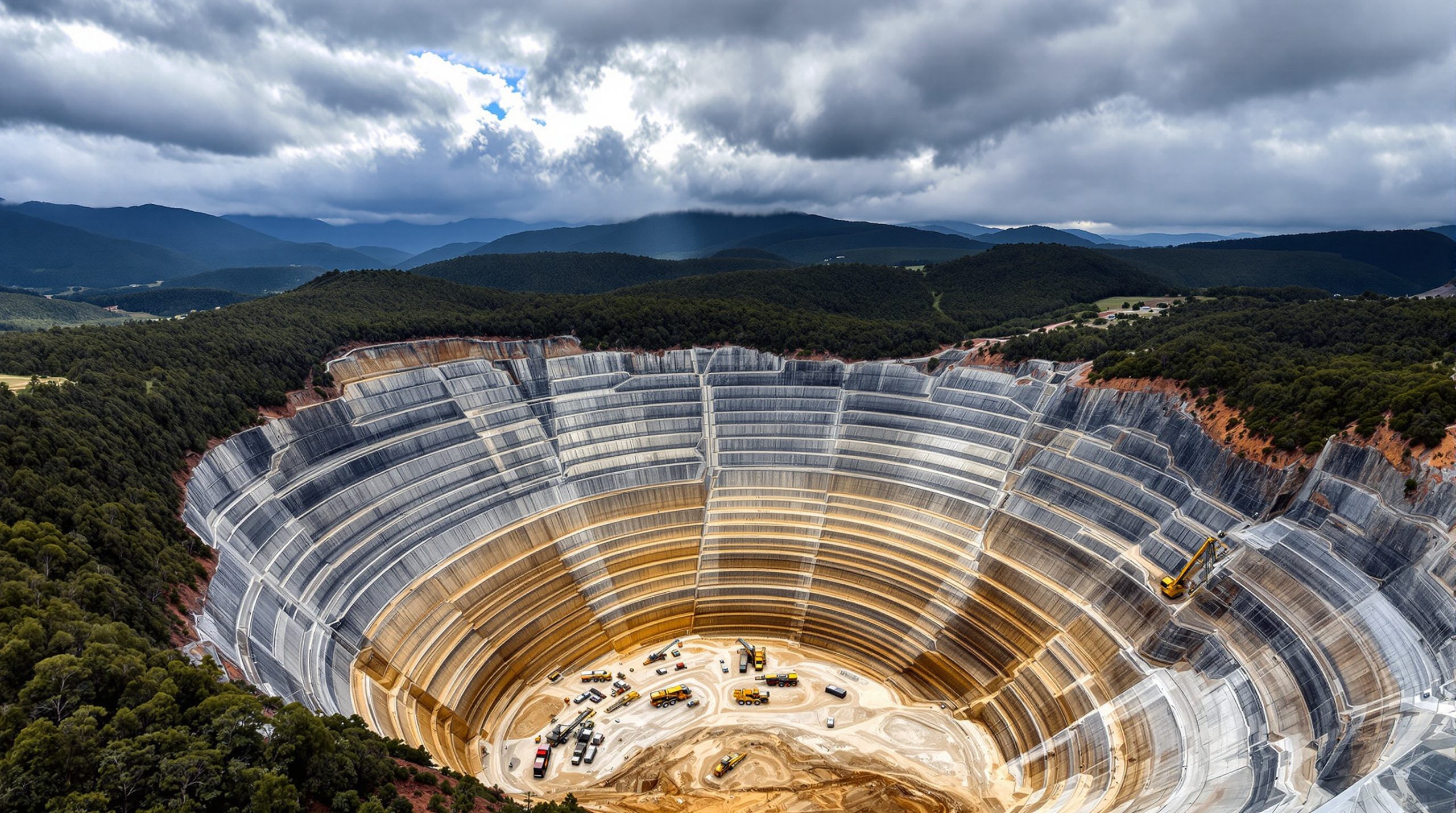Godolphin Resources has revealed a series of exceptional drill results at its Lewis Ponds Gold-Silver Project in New South Wales, painting a picture of substantial expansion potential far beyond the current resource estimate. The latest drilling programme, characterised by its diamond drilling technique, has not only confirmed the presence of high-grade mineralisation zones but has also underscored the possibility of discovering new mineralised corridors.
The final drillhole (GLPDD009) reported several remarkable intercepts, including:
- 51.75m at 1.81g/t gold equivalent from 276.05m with an embedded high-grade core of 7.85m at 5.37g/t gold equivalent within the Torphy's Lode.
- 42.7m at 1.60g/t gold equivalent from 225.0m with 5.5m at 5.50g/t gold equivalent observed in the Spicers Lode.
- 13.45m at 0.56g/t gold equivalent from 162m, which marks a newly identified zone of mineralisation.
These notable results serve as a robust underscore of the project's potential. In particular, both the intercept from the Torphy's Lode and the fresh hanging wall mineralisation lie beyond the boundaries of the existing Mineral Resource Estimate, indicating a logical avenue for resource growth.
What Makes Lewis Ponds an Underappreciated Asset?
Lewis Ponds has long been known for its impressive JORC (2012) Inferred Resource, which comprises:
- 6.20 million tonnes at 2.0g/t gold.
- A silver grade of 80g/t.
- An estimated 398,000 ounces of gold.
- Approximately 15.9 million ounces of silver.
- Additional base metals that include 2.7% zinc, 1.6% lead, and 0.2% copper.
Historically, the project had been primarily focused on base metals, meaning that its true potential as a gold-silver deposit had not been fully realised. Godolphin’s recalibration to emphasise the precious metals component is now providing tangible results. With multiple expansion targets identified and a pronounced focus on precious metals recovery, the strategic pivot is expected to add significant value.
The project, located in the prolific Lachlan Fold Belt of New South Wales—an area already famed for hosting major gold-copper deposits—boasts a range of geological and technical characteristics that enhance its investment appeal. These include a robust resource base and favourable geophysical attributes that set the stage for further exploration success.
How Are Drilling Results Shaping the Future?
The recent drilling campaign has been more than a routine exercise in subsurface evaluation. The robust results imply a number of exciting opportunities for future exploration and resource expansion, such as:
- Expanding both laterally and in depth beyond the previously understood mineralised envelope.
- Uncovering additional high-grade zones that have been undersampled in the past.
- Confirming that the structural complexities of the Lewis Ponds system can lead to multiple, high-quality intercepts.
- Validating the use of geophysical methods which indicate that the current resource is only a portion of the full potential geological setting.
A striking observation is that the new hanging wall mineralisation was discovered outside the bounds of the current resource estimate. This finding is a strong signal to investors and geologists alike that the Lewis Ponds system may harbour much more extensive and economically viable mineralisation than originally envisaged.
What is the Role of Induced Polarisation in Exploration?
A crucial element to the Lewis Ponds exploration strategy is the use of Induced Polarisation (IP) surveys. This geophysical technique is invaluable in the search for mineral-rich areas as it measures the electrical chargeability of subsurface materials. Here are some vital points to note on how IP surveys contribute to the exploration process:
- They help identify chargeable materials, typically sulphide minerals, which often host gold and silver.
- The time decay of voltage after an applied electrical current is measured, highlighting the presence of minerals like pyrite, galena, and chalcopyrite.
- Distinct geophysical signatures produced by these sulphide minerals can be used to map out areas that warrant further drilling.
- Numerous untested IP anomalies have been identified to the north and south of the current resource area, all of which display similar geophysical traits to the known mineralisation.
The utilisation of IP surveys bolsters the strategic approach, allowing the company to target drilling efforts more efficiently and potentially unveil additional high-grade zones that may have been missed using conventional methods alone.
How Is Future Exploration Planned?
With drilling results now firmly in hand, Godolphin is set to further unlock the value of Lewis Ponds through a series of follow-up activities. The near-term plans include:
- Metallurgical testing – Focusing on optimising gold and silver recovery. The results of these tests, anticipated over the coming months, are expected to influence future operational strategies.
- Detailed field work – Investigating the surface expressions of untested geophysical anomalies to pinpoint further targets.
- Resource expansion initiatives – Targeting vast undrilled areas both within and outside of the current resource envelope to reveal additional mineralisation zones.
This multi-pronged strategy not only aims to enhance the overall resource base but also to transition the project from a base metal prospect to a prime precious metals asset. By adjusting the focus towards optimising for gold and silver rather than traditional base metals, the project stands to unlock substantial additional shareholder value.
Why Investors Should Take Note
The Lewis Ponds project presents a compelling narrative for investors, backed by solid drilling data and a comprehensive exploration strategy. The key reasons to keep an eye on this project include:
- An established resource base that already includes 398,000 ounces of gold and 15.9 million ounces of silver.
- Multiple expansion targets that share similar geophysical signatures to those of the proven mineralisation.
- A strategic shift toward the extraction of precious metals, optimised in a rising gold price environment.
- The project’s location within the Lachlan Fold Belt, an area known for its prolific mining history and geologically favourable conditions.
- Upcoming near-term catalysts, such as metallurgical test results and further exploration follow-ups, which could provide additional clarity on the project’s economic viability.
Jeneta Owens, the Managing Director, encapsulated this enthusiasm when she noted, "Production of a viable precious metals concentrate is anticipated to unlock significant value from Lewis Ponds, as all previous metallurgical test work focussed on producing base metal concentrates." This realisation marks a pivotal moment for the project, signalling a mature phase of exploration that could translate into significant commercial success.
What Technical Insights Define the Deposit?
The Lewis Ponds deposit is categorised as a volcanic-hosted massive sulphide (VHMS) deposit. This classification is not only pivotal in understanding the formation of the deposit but also in shaping exploration methods. The key technical insights into VHMS deposits include:
- They form through hydrothermal processes on the seafloor, where hot, metal-rich fluids mix with cold seawater, precipitating sulphide minerals.
- These deposits are typically associated with submarine volcanic activity, which contributes to a stratiform distribution of mineralisation.
- The Lewis Ponds deposit is hosted within Silurian felsic to intermediate volcanic rocks, integrating both the base metals (such as zinc, lead, and copper) and the precious metals (gold and silver).
- Its polymetallic composition, along with the presence of typical sulphide minerals like pyrite, sphalerite, galena, and chalcopyrite, confirms its VHMS status.
The intricate geological setting of Lewis Ponds is augmented by its location within the Lachlan Fold Belt, an area renowned for its metallogenic potential. The complex structural geology of this region implies that post-depositional processes may have further concentrated the mineralisation, creating distinct zones that offer high-grade potential.
Concluding Thoughts
The latest drill results at Lewis Ponds are a testament to the project’s significant untapped potential. With robust high-grade intercepts and strategic reorientation towards precious metals, Godolphin Resources is well-positioned to advance further resource expansion through methodical exploration. The integration of sophisticated techniques, such as Induced Polarisation surveys, further enhances the ability to locate additional mineralisation corridors.
Investors are presented with an opportunity to gain exposure to a growing precious metals asset, derived from a solid resource base and a thorough exploration programme. As the project advances through metallurgical testing and field validation, the industry will be watching closely to see if the promising early results can be transformed into a sustainable and economically viable operation.
The strategic combination of innovative exploration techniques, detailed geological understanding, and forward-thinking resource planning makes Lewis Ponds a standout project in the mid-tier exploration space.
Ready to Tap into Lewis Ponds' Gold-Silver Potential?
Want to discover how Godolphin Resources is transforming Lewis Ponds from a base metal prospect into a significant gold-silver asset? With exceptional drill results showing high-grade intercepts beyond the existing resource boundaries, Lewis Ponds presents a compelling investment opportunity in the prolific Lachlan Fold Belt. Learn more about this evolving story and how you can be part of Godolphin's journey by watching their latest presentation here.




